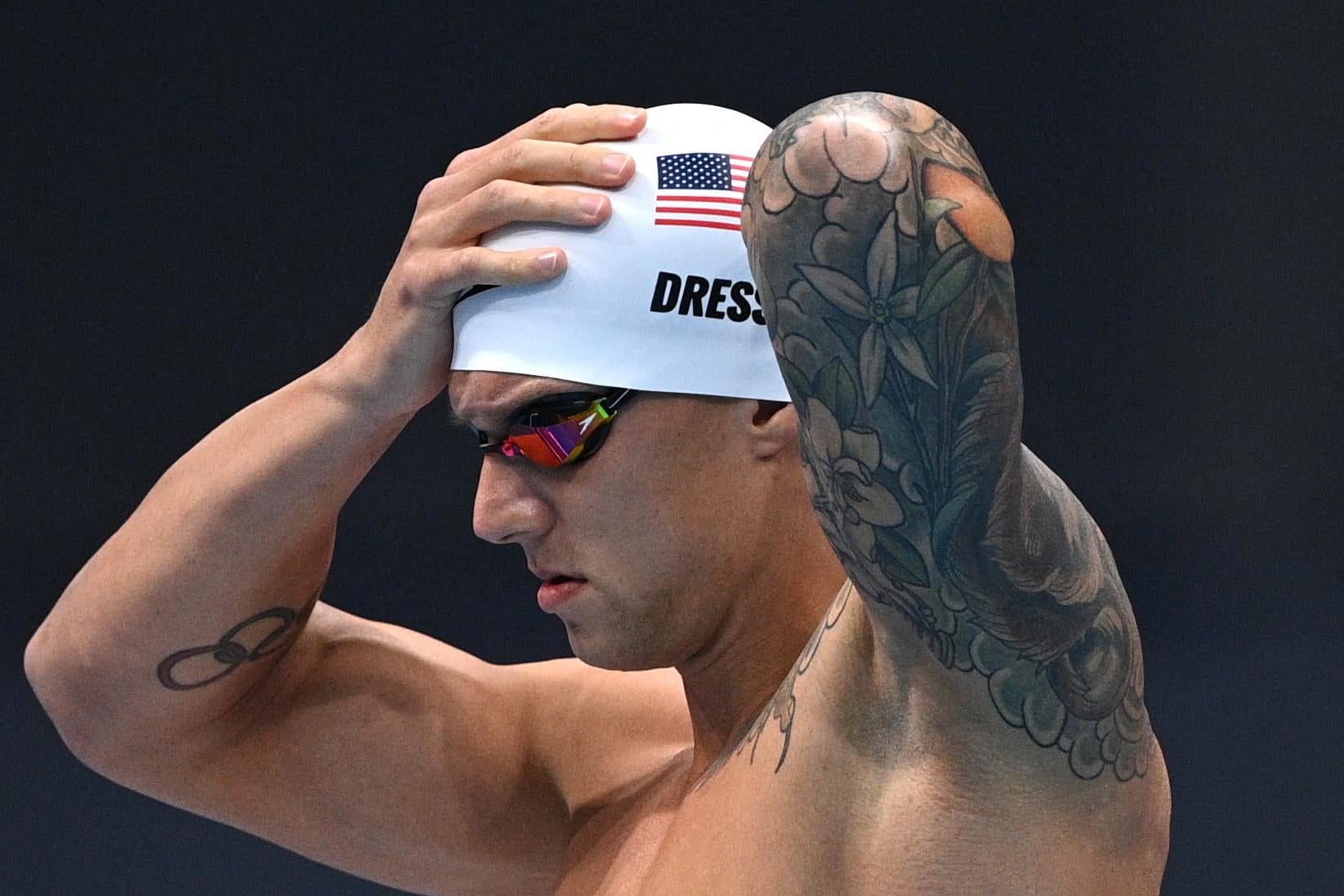How long after a tattoo can you swim? It’s a common question among tattoo enthusiasts. While tattoos are a beautiful form of self-expression, it’s crucial to take proper care of your new ink during the healing process. One concern that often arises is how long you should wait before swimming. In this article, we will explore the optimal post-inking wait time for a safe swim, ensuring your tattoo heals beautifully without any complications.
1. Understanding the Tattoo Healing Process:
Before diving into the topic of swimming after getting a tattoo, it’s essential to have a basic understanding of how tattoos heal. The healing process typically takes around two to four weeks, during which your skin undergoes various stages of regeneration.
The Initial Stage: Inflammation and Blood Clotting
Right after getting a tattoo, your skin undergoes an initial stage of healing characterized by inflammation and blood clotting. The tattooing process creates small punctures in the skin, resulting in bleeding. Your body’s natural response is to send blood cells to the area to form a clot and initiate the healing process.
The Scabbing and Peeling Stage
After the initial inflammation subsides, the tattooed area will start to scab and peel. Scabbing is a natural part of the healing process as your body works to protect the newly tattooed skin. As the scabs form, your skin begins to regenerate underneath.
Formation of New Skin and Color Settling
As the scabs gradually fall off, the underlying skin starts to regenerate and form new layers. During this stage, the tattoo’s colors may appear slightly faded or dull. Don’t worry – this is normal! The pigments will begin to settle into the deeper layers of your skin over time.
Fully Healed and Settled Tattoo
Finally, after several weeks, your tattoo will be fully healed and settled. The colors will become more vibrant, and the skin texture will return to normal. At this stage, you can safely engage in activities like swimming without compromising the integrity of your tattoo.
2. Factors Affecting Tattoo Healing:
Several factors can influence how quickly your tattoo heals, and it’s important to consider these factors when determining when it’s safe to swim.
Tattoo Size and Complexity
The size and complexity of your tattoo design play a role in how long it takes to heal. Larger tattoos with intricate details may require more time for the skin to regenerate fully.
Tattoo Location
The location of your tattoo on your body can also affect healing time. Areas with thinner skin, such as the hands, feet, or ribs, may take longer to heal compared to areas with thicker skin, like the upper arms or thighs.
Individual Healing Ability
Each person’s healing ability varies, and some individuals may naturally heal faster than others. Factors such as age, overall health, and immune system strength can impact how quickly your tattoo heals.
Aftercare Practices
The way you care for your tattoo during the healing process can significantly influence its healing time. Following your tattoo artist’s aftercare instructions, such as keeping the tattoo clean, avoiding excessive moisture, and refraining from picking at scabs, can help promote faster healing.
Environmental Factors
Environmental factors, such as exposure to sunlight, humidity, and pollution, can also affect tattoo healing. Protecting your tattoo from prolonged sun exposure and avoiding environments that may introduce irritants or contaminants can contribute to a smoother healing process.
3. Why You Shouldn’t Swim Right After Getting a Tattoo:
Immediately after getting a tattoo, your skin is in a vulnerable state, and swimming should be avoided during this time to prevent complications.
Risk of Infection
Exposing a fresh tattoo to pool water, seawater, or other bodies of water increases the risk of infection. These environments can contain bacteria, viruses, and other microorganisms that may enter the open skin and lead to infections.
Prolonged Water Exposure
Extended exposure to water can also affect the healing process. Water can soften the scabs that form on the tattoo, increasing the chances of them being disrupted or prematurely removed. This can result in color loss, patchy healing, or even scarring.
Chemicals and Irritants
Chlorine, salt, and other chemicals present in pool water or seawater can irritate the skin, causing redness, itching, and discomfort. These substances may also interfere with the healing process and affect the vibrancy and longevity of your tattoo.
Avoidance of Excessive Moisture
During the initial healing stage, it’s crucial to keep your tattooed skin clean and dry. Swimming can introduce excess moisture to the tattoo, which may hinder the formation of a protective layer of new skin and prolong the healing process.
Listen to Your Tattoo Artist
Your tattoo artist is an expert in the field and will provide specific aftercare instructions tailored to your tattoo. It’s important to follow their advice and refrain from swimming until they give you the go-ahead.
4. The Importance of Aftercare:
Proper aftercare is crucial for the healing process and overall health of your tattoo. Following your tattoo artist’s instructions will help ensure optimal healing and minimize the risk of complications.
Keeping the Tattoo Clean
Regularly cleaning your tattoo with a mild, fragrance-free soap and lukewarm water is essential to prevent infections. Gently pat the area dry with a clean towel, avoiding any harsh rubbing.
Applying a Healing Ointment
Your tattoo artist may recommend applying a thin layer of a specialized healing ointment or moisturizer to your tattoo. These products help keep the skin moisturized, promote healing, and reduce the risk of scabs becoming too dry or brittle.
Avoiding Excessive Moisture
While it’s important to keep your tattoo clean, it’s equally important not to over-moisturize it. Excessive moisture can prolong healing and increase the risk of infection. Follow your tattoo artist’s guidelines regarding how often and how much to moisturize.
Avoiding Sun Exposure
Direct sunlight can be harmful to a healing tattoo, causing fading and potential damage. Protect your tattoo from the sun’s rays by covering it with clothing or applying a broad-spectrum, high SPF sunscreen once it has fully healed.
No Picking or Scratching
It can be tempting to scratch or pick at scabs or flakes that form during the healing process. However, this can disrupt the healing and lead to scarring or color loss. Resist the urge and let the scabs naturally fall off on their own.
Seeking Professional Advice if Needed
If you have any concerns or notice signs of infection, such as excessive redness, swelling, or pus, it’s crucial to seek professional advice. Your tattoo artist or a healthcare professional can provide guidance and recommend appropriate treatment if necessary.
5. Waiting Time for Swimming:
While the recommended waiting time before swimming after getting a tattoo is typically around two weeks, it’s important to understand that this timeframe can vary depending on several factors.
Tattoo Size and Complexity
Larger and more complex tattoos may require additional time to heal properly before exposing them to water. Intricate designs or tattoos covering a significant portion of the body may need a longer healing period.
Individual Healing Ability
Each person’s body heals at its own pace. Factors such as age, overall health, and immune system function can influence how quickly your tattoo heals. Listen to your body and give it the time it needs to recover.
Tattoo Location
The location of your tattoo plays a role in determining how long you should wait before swimming. Tattoos in areas prone to friction, such as joints or areas that come into contact with clothing, may require extra time to heal.
Tattoo Artist Recommendations
Your tattoo artist is the best source of advice when it comes to determining the appropriate waiting time before swimming. They have the expertise and experience to evaluate your specific tattoo and provide personalized guidance.
Observing the Healing Progress
Rather than relying solely on a specific timeframe, it’s important to observe the healing progress of your tattoo. If the tattooed area has fully healed, with no scabbing, peeling, or other signs of irritation, it may be a good indication that it’s safe to swim.
Err on the Side of Caution
If you’re unsure or have any doubts about whether it’s safe to swim, it’s best to err on the side of caution and wait a little longer. Taking extra time to ensure your tattoo is fully healed can help prevent potential complications.
6. Signs That Your Tattoo is Ready for Swimming:
Instead of relying solely on a specific timeframe, it’s important to observe the healing progress of your tattoo to determine when it’s safe to swim. Look for these signs that indicate your tattoo is ready for water activities:
Absence of Scabs or Flaking
If your tattoo has completely shed any scabs or flakes, it’s a good indication that the healing process is nearing completion. Scabs or flakes can be fragile and easily disrupted by water, so it’s best to wait until they are fully gone.
No More Peeling or Itching
Peeling and itching are common during the healing process, but once these symptoms have subsided, it suggests that the top layer of your skin has regenerated and the tattoo is well on its way to being fully healed.
Tattoo Appears Fully Healed
Take a close look at your tattoo. If it appears smooth, with no signs of redness, swelling, or irritation, and the colors have settled into the skin, it’s a strong indication that your tattoo has fully healed and is ready for swimming.
No Sensitivity or Pain
If the tattooed area is no longer sensitive to touch and does not cause any pain or discomfort, it suggests that the underlying skin has healed, and the tattoo is now well-established.
Consult with Your Tattoo Artist
If you’re uncertain whether your tattoo is ready for swimming, it’s always wise to consult with your tattoo artist. They can assess the healing progress, provide personalized advice, and give you the green light when it’s safe to take the plunge.
7. Special Considerations for Water Activities:
If you’re an avid swimmer or engage in other water activities regularly, it’s important to take special considerations when planning for a new tattoo. Here are some factors to keep in mind:
Location and Design
Discuss with your tattoo artist the location and design of your tattoo, particularly if you frequently wear swimwear or participate in activities that may cause friction or rubbing against the tattooed area. Consider how water exposure and movement may affect the healing process.
Prolonged Submersion
Extended periods of submersion in water, such as swimming laps or diving, can soften the scabs and compromise the healing process. It’s best to avoid prolonged submersion until your tattoo has fully healed to minimize the risk of complications.
Protective Clothing
Consider wearing protective clothing, such as a rash guard or swim shirt, to cover your tattoo while swimming. This can provide an extra layer of protection and reduce direct water contact, minimizing the chances of irritation or damage.
Waterproof Sunscreen
If your tattoo is fully healed and you plan on swimming outdoors, apply a waterproof sunscreen with a high SPF to protect your tattoo from the sun’s harmful rays. Direct sunlight can fade the colors and damage the skin over time.
Post-Swim Aftercare
After swimming, make sure to rinse off any chlorine, saltwater, or other chemicals from your tattoo. Pat it dry gently and reapply a thin layer of moisturizer or healing ointment to keep the skin hydrated and aid in the recovery process.
Listen to Your Body
Pay attention to how your tattooed skin reacts to water activities. If you experience any unusual redness, swelling, or discomfort, it may be a sign that you need to take a break from swimming and allow your tattoo more time to heal.
8. Protecting Your Tattoo While Swimming:
Even after the recommended healing period, it’s important to take precautions to protect your tattoo while swimming. Here are some measures you can take:
Waterproof Sunscreen
Before heading into the water, apply a waterproof sunscreen with a high SPF to your tattoo. This will help protect it from harmful UV rays and prevent fading or damage.
Limit Exposure to Chlorinated Water
Chlorinated pool water can be harsh on tattoos. Try to limit your time in chlorinated pools and rinse off with clean water afterward to remove any residual chlorine.
Avoid Hot Tubs and Saunas
Hot tubs and saunas can soften the skin and cause excessive sweating, which may be detrimental to a healing tattoo. It’s best to avoid these environments until your tattoo is fully healed.
Wear Protective Clothing
If you’re swimming in natural bodies of water, such as the ocean or a lake, consider wearing protective clothing like a rash guard or swim shirt to shield your tattoo from direct sun exposure and potential irritants in the water.
Avoid Prolonged Submersion
While it’s generally safe to swim with a healed tattoo, it’s still advisable to avoid prolonged submersion in water. Extended exposure can lead to excessive moisture, which may disrupt the healing process.
Pat Dry Gently
After swimming, pat your tattoo dry gently with a clean towel. Avoid rubbing or scrubbing the area, as this can cause irritation or damage to the tattooed skin.
Moisturize After Swimming
Once your tattoo is dry, apply a thin layer of moisturizer or healing ointment to keep the skin hydrated. This will help maintain the tattoo’s appearance and promote overall skin health.
Listen to Your Tattoo Artist
Your tattoo artist is your best resource for personalized advice on how to protect your specific tattoo while swimming. They can provide tailored recommendations based on their expertise and knowledge of your tattoo.
9. Dealing with Unexpected Complications:
While precautions can minimize the risk, there is still a possibility of unexpected complications when swimming with a new tattoo. Here’s what to do if you encounter any issues:
Signs of Infection
If you notice signs of infection, such as increased redness, swelling, warmth, or discharge, it’s crucial to take action. Clean the area with mild soap and water, apply an antibiotic ointment, and seek medical attention if the symptoms worsen.
Excessive Redness or Swelling
If your tattooed skin becomes excessively red or swollen after swimming, it may indicate irritation or an allergic reaction. Apply a cold compress to reduce swelling and consult with your tattoo artist or a healthcare professional if the symptoms persist.
Delayed Healing
If your tattoo is taking longer than expected to heal or if you notice prolonged scabbing, peeling, or discomfort after swimming, it’s advisable to consult your tattoo artist. They can assess the situation and provide guidance on next steps.
Color Loss or Fading
In some cases, prolonged water exposure can cause color loss or fading in a tattoo. If you notice significant changes in the vibrancy of your tattoo after swimming, it’s best to consult with your tattoo artist for advice on potential touch-up options.
Scarring
If you experience excessive scarring or keloid formation after swimming with a new tattoo, it’s important to consult with a healthcare professional. They can evaluate the situation and recommend appropriate treatment options to minimize scarring.
Follow Aftercare Instructions
If complications arise, it’s crucial to follow any additional aftercare instructions provided by your tattoo artist or healthcare professional. This may include applying specialized creams, taking prescribed medications, or adjusting your skincare routine.
Stay Calm and Seek Professional Advice
If you encounter any unexpected complications, it’s essential to stay calm and seek professional advice. Your tattoo artist and healthcare professionals are there to support you and ensure the best possible outcome for your tattoo.
10. Enjoying Your Swim with a Healed Tattoo:
Once your tattoo has fully healed, you can confidently enjoy swimming without worrying about potential damage. Here’s how to make the most of your swim with a healed tattoo:
Maintain Good Skincare Habits
Even after your tattoo has healed, it’s important to continue practicing good skincare habits. Keep your tattoo moisturized with a gentle lotion or tattoo-specific aftercare product to preserve its appearance and prevent dryness.
Apply Sunscreen
Before exposing your tattoo to the sun, apply a broad-spectrum sunscreen with a high SPF. This will help protect your tattoo from harmful UV rays, preventing fading and maintaining its vibrancy over time.
Reapply Sunscreen as Needed
If you’re spending an extended time in the sun or participating in water activities, remember to reapply sunscreen regularly. Follow the instructions on the sunscreen bottle and pay extra attention to your tattooed skin.
Avoid Excessive Sun Exposure
While it’s enjoyable to soak up the sun, excessive exposure can be harmful to your tattoo. Seek shade or cover your tattooed skin with clothing when the sun’s rays are the strongest to prevent potential damage.
Stay Hydrated
Drinking plenty of water before, during, and after swimming is crucial for overall skin health. Proper hydration helps keep your skin moisturized from within and promotes optimal healing and appearance of your tattoo.
Protect Your Tattoo from Harsh Chemicals
Avoid exposing your tattoo to harsh chemicals, such as strong soaps, cleaning agents, or beauty products. These substances can irritate the skin and potentially affect the longevity and appearance of your tattoo.
Enjoy Your Swim!
Now that your tattoo has fully healed, it’s time to enjoy your swim without worry. Take pleasure in the water activities you love, all while proudly displaying your beautiful, healed tattoo.
In conclusion, swimming after getting a tattoo requires careful consideration and adherence to proper aftercare practices. While the general recommendation is to wait at least two weeks before swimming, individual factors such as tattoo size, location, and healing ability can impact the specific waiting time. It’s crucial to closely monitor the healing progress of your tattoo and consult with your tattoo artist for personalized advice. Protecting your tattoo while swimming, using sunscreen, and practicing good skincare habits are essential to preserve its appearance and prevent complications. If any unexpected issues arise, seek professional advice promptly. With the proper precautions and patience, you can enjoy your swim with a healed tattoo, proudly displaying your unique form of self-expression.

As a passionate water enthusiast, I’ve spent my life exploring the depths of swimming and sharing my experiences with the world. Stroke Swimming is more than just a blog; it’s a deep dive into the world of swimming. Here, you’ll find a treasure trove of information, tips, and insights to help both beginners and seasoned swimmers enhance their skills, knowledge, and appreciation for this timeless art.





